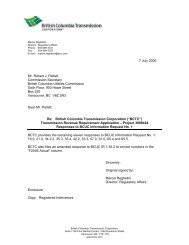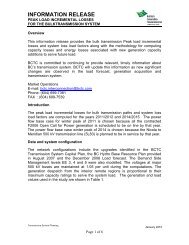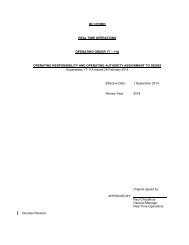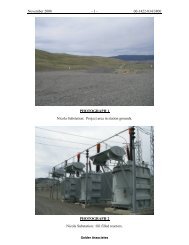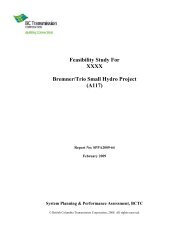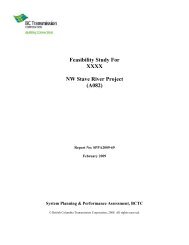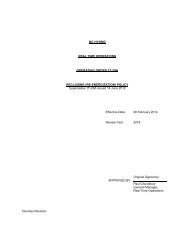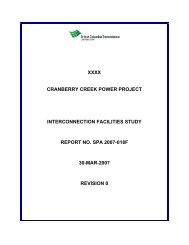Evidence on the Adequacy of First Nations Consultation - BC Hydro ...
Evidence on the Adequacy of First Nations Consultation - BC Hydro ...
Evidence on the Adequacy of First Nations Consultation - BC Hydro ...
Create successful ePaper yourself
Turn your PDF publications into a flip-book with our unique Google optimized e-Paper software.
Perhaps <strong>the</strong> greatest <strong>of</strong> <strong>the</strong>se impacts happened <strong>on</strong> <strong>the</strong> eastern porti<strong>on</strong>s <strong>of</strong> traditi<strong>on</strong>al Ktunaxa<br />
territory. The eastward situati<strong>on</strong> <strong>of</strong> Plains tribes, especially <strong>the</strong> Blackfoot, gave <strong>the</strong>m <strong>the</strong> first<br />
opportunities to trade with <strong>the</strong> westward moving agents <strong>of</strong> <strong>the</strong> Huds<strong>on</strong>’s Bay and North West<br />
Companies who <strong>the</strong>mselves were eager to improve <strong>the</strong> efficiency <strong>of</strong> fur collecti<strong>on</strong> by introducing<br />
arms to Indian hunters. Sporting <strong>the</strong> new rifles, driven by <strong>the</strong> competiti<strong>on</strong> for buffalo access and<br />
protective <strong>of</strong> <strong>the</strong>ir new status as middlemen, <strong>the</strong> Blackfoot Indians and <strong>the</strong>ir allies so<strong>on</strong> obtained <strong>the</strong><br />
upper hand over <strong>the</strong> traditi<strong>on</strong>al weap<strong>on</strong>s <strong>of</strong> <strong>the</strong> Ktunaxa and Fla<strong>the</strong>ad Salish fur<strong>the</strong>r west.<br />
As a result <strong>of</strong> this military imbalance, most historians and ethnographers [e.g., Turney-High] agree<br />
that <strong>the</strong> porti<strong>on</strong> <strong>of</strong> <strong>the</strong> Ktunaxa living <strong>on</strong> or near <strong>the</strong> Plains were forced to withdraw into <strong>the</strong> Rockies<br />
and fur<strong>the</strong>r west to join <strong>the</strong>ir linguistic brethren in what approximates <strong>the</strong>ir post-c<strong>on</strong>tact territory.<br />
This noti<strong>on</strong> was first advanced by David Thomps<strong>on</strong> and Alexander Henry, <strong>the</strong> latter stating: 19<br />
Al<strong>on</strong>g <strong>the</strong> Clearwater, and near <strong>the</strong> foot <strong>of</strong> <strong>the</strong> mountains are still to be seen <strong>the</strong> remains <strong>of</strong> some <strong>of</strong> <strong>the</strong><br />
dwellings <strong>of</strong> <strong>the</strong> Kootenays, built <strong>of</strong> wood, straw, and pine branches. The same are observed al<strong>on</strong>g<br />
Riviére de la Jolie Prairie and Ram river. This gives us every reas<strong>on</strong> to suppose that nati<strong>on</strong> formerly<br />
dwelt al<strong>on</strong>g <strong>the</strong> foot <strong>of</strong> <strong>the</strong>se mountains and even as far down as our present establishment, near which<br />
<strong>the</strong> remains <strong>of</strong> some <strong>of</strong> <strong>the</strong>ir lodges are still to be seen. About <strong>the</strong> time <strong>the</strong> Kootenays were in<br />
possessi<strong>on</strong> <strong>of</strong> this part <strong>of</strong> <strong>the</strong> country, <strong>the</strong> Snare Indians dwelt <strong>on</strong> <strong>the</strong> Kootenay or Columbia. But <strong>the</strong><br />
former, being driven into <strong>the</strong> mountains by <strong>the</strong> different tribes who lived E. <strong>of</strong> <strong>the</strong>m, with whom <strong>the</strong>y<br />
were perpetually at war, in <strong>the</strong>ir turn waged war up<strong>on</strong> <strong>the</strong>ir harmless neighbours <strong>on</strong> <strong>the</strong> W., <strong>the</strong> Snare<br />
Indians, and so<strong>on</strong> drove <strong>the</strong>m <strong>of</strong>f <strong>the</strong> land <strong>the</strong> Kootenays now inhabit. This is <strong>on</strong> <strong>the</strong> upper part <strong>of</strong> <strong>the</strong><br />
Columbia, and <strong>on</strong> Ram [sic] river, a little S. <strong>of</strong> it, now called McGillivray’s river, but formerly termed<br />
by <strong>the</strong> natives Flat Bow river, from a tribe <strong>of</strong> Indians who <strong>the</strong>n inhabited <strong>the</strong> lower part <strong>of</strong> it….The<br />
Snare Indians, it seems, retired northward to an uninhabited part <strong>of</strong> <strong>the</strong> Rocky mountains, where <strong>the</strong>y<br />
c<strong>on</strong>tinue to wander, a most wretched and defenceless people, who never war up<strong>on</strong> any <strong>of</strong> <strong>the</strong>ir<br />
neighbours.<br />
Fellow fur trader Ross Cox also wrote <strong>of</strong> <strong>the</strong> initial impact <strong>of</strong> <strong>the</strong> gun <strong>on</strong> Ktunaxa-Blackfoot range<br />
wars: 20 The Coot<strong>on</strong>ais are <strong>the</strong> remnant <strong>of</strong> a <strong>on</strong>ce brave and powerful tribe, who, like <strong>the</strong> Flat-heads, were<br />
perpetually engaged in war with <strong>the</strong> Black-feet for <strong>the</strong> right <strong>of</strong> hunting <strong>on</strong> <strong>the</strong> buffalo grounds.<br />
Previous to our arrival am<strong>on</strong>g <strong>the</strong>m <strong>the</strong>y entertained <strong>the</strong> most dreadful hatred against white men, to<br />
whom <strong>the</strong>y attributed all <strong>the</strong>ir misfortunes, owing to <strong>the</strong> assistance which <strong>the</strong>ir enemies received from<br />
<strong>the</strong> North-west Company’s people to <strong>the</strong> eastward <strong>of</strong> <strong>the</strong> mountains.<br />
Like Thomps<strong>on</strong> and Henry, some modern authorities appear to hold that this was a general westward<br />
movement, with a few believing that <strong>the</strong> Ktunaxa are relative newcomers [since <strong>the</strong> 1700s] to <strong>the</strong>ir<br />
current treaty claim area. On <strong>the</strong> strength <strong>of</strong> some key informants, Turney-High, <strong>the</strong> most prominent<br />
<strong>of</strong> <strong>the</strong> Ktunaxa ethnographers, believed that <strong>the</strong> ultimate origins <strong>of</strong> <strong>the</strong> Ktunaxa were “not <strong>on</strong>ly an<br />
eastern provenance…but even a trans-Rocky mountain <strong>on</strong>e”, although he evidently felt that this was<br />
far earlier than <strong>the</strong> 1700s. 21 The B.C. Department <strong>of</strong> Educati<strong>on</strong> guide book for B.C. schools,<br />
developed in c<strong>on</strong>juncti<strong>on</strong> with B.C. Archives in <strong>the</strong> early 1950s, attempted to syn<strong>the</strong>size oral traditi<strong>on</strong><br />
and documentary sources into <strong>the</strong> following:<br />
19 From Coues, E., pp. 703-706.<br />
20 Cox, R., Adventures <strong>on</strong> <strong>the</strong> Columbia, pg. 233.<br />
21 Harry Turney-High, Ethnography <strong>of</strong> <strong>the</strong> Kutenai, p. 10. Note that <strong>on</strong> <strong>the</strong> same page his acknowledgment <strong>of</strong> a “str<strong>on</strong>g<br />
traditi<strong>on</strong>” <strong>of</strong> <strong>the</strong> Ktunaxa that this westward movement was at “a very ancient time”. Also, he accepts “Tobacco Plains,<br />
or <strong>the</strong> Big Village” as “<strong>the</strong> ancient Kutenai ‘capital’ ” [p. 16].<br />
13<br />
Page 157 <strong>of</strong> 200






